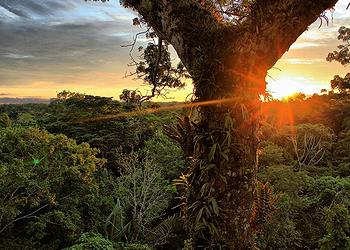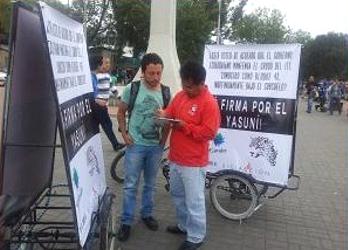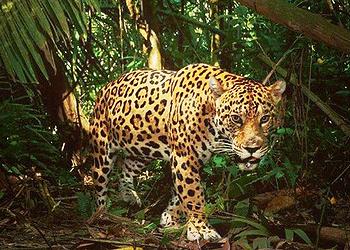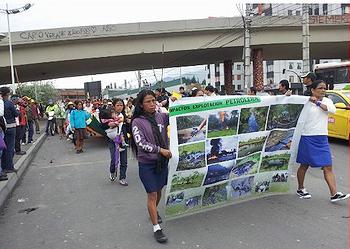Oil Vote Deadline Looms for Ecuador’s Yasuní National Park
By Kelly Swing
QUITO, Ecuador, April 8, 2014 (ENS) – In 2007, for the meager sum of US$3.6 billion, Ecuador’s President Rafael Correa offered the world a chance to buy into a conservation plan, called the Yasuní-ITT Initiative, to save his country’s easternmost sector from oil extraction.

Sunrise in the Tiputini area of Yasuni National Park, Dec. 18, 2011 (Photo by Sara y Tzunki (Cecilia e Francesco)
The ITT concession area, named for three sites within its boundaries – Ishpingo, Tambococha and Tiputini – makes up about 1/12th of the Yasuní Biosphere Reserve. It represents an opportunity to conserve up to 10 percent of all species on the planet.
This Initiative also would have protected clans of indigenous peoples living in voluntary isolation and avoided the release of over 400 million tons of carbon dioxide emissions.
Long story short – the world didn’t come up with the money. In August 2013, President Correa pulled the plug on this opportunity, stating that plans to drill there would be pushed forward as a means of alleviating widespread poverty. In the same announcement, he promised that “less than 1/1000th of the park would be impacted.”
But environmentalists are desperate to avoid oil development in what is left of this biodiversity hotspot; they are determined to take the issue to a national referendum vote.
If 584,000 signatures can be collected by the April 12 deadline, the fate of Yasuni can be decided by a national vote rather than depending upon the decision of a few politicians.
The question, “Do you agree that the Ecuadorean government should keep the crude in the ITT, known as block 43, underground indefinitely?”

Collecting signatures to support a referendum in Carolina Park, Quito, Ecuador (Photo courtesy SOS Yasuni)
The collection of signatures is being led by Yasunidos, a newly formed alliance of groups seeking to overturn Correa’s abandonment of the Yasuní-ITT Initiative. Some polls suggest that general support for protecting the ITT may reach 70 percent, and several activists say they are fast approaching the goal as the deadline looms.
President Correa openly discounts the likelihood that the required support can be mustered. He has already commented that he expects as much as 40 percent of submitted signatures not to be legitimate, setting up a scenario in which the petition could easily be ignored.
Even if the minimum number of signatures were surpassed by thousands, when detailed scrutiny is applied to each entry, it may be simple to discard a huge proportion of them due to technicalities.
Based on recently increased levels of exploration and construction in the Yasuní Biosphere Reserve, it appears that Ecuador has taken the world’s lack of financial contributions to the ITT Initiative to mean that the region’s nature is not actually worth the bother.
As President Correa has recently repeated, Ecuador simply will not continue to be a “beggar sitting on a sack of gold” just because a few environmentalists are not willing to accept some “minor sacrifices.”
The Yasuní Biosphere Reserve, recognized by UNESCO as a world-class piece of natural heritage, encompasses the Yasuní National Park; the Waorani Ethnic Reserve, a reduced version of the traditional lands of this native group, and a variable buffer zone surrounding a contiguous geographic management unit. The entire Reserve amounts to about 2.7 million hectares (roughly 10,000 sqare miles).
The Yasuní Biosphere Reserve is considered the heart of the Earth’s most biodiverse ecoregion, western Amazonia.
Yasuní itself is inhabited by 150 species of frogs, around 200 species of mammals, 600 species of birds and over 2,000 species of trees. That amounts to 50 percent more frog kinds than in the United States and Canada combined, 75 percent of the number of bird species there, and three times the number of tree species that grow in those two countries.
All that biodiversity is packed into an area the size of one of the smaller U.S. states such as Maryland. Among the birds are a few dozen species of macaws, parrots and parakeets as well as toucans, curassows and the magnificent Harpy eagle.

The jaguar, Panthera onca, is the largest feline in the Americas, and the most emblematic species of Yasuní National Park (Photo by Steve Winter / Yasuni-ITT)
The more than 120 different kinds of reptiles, include the boa constrictor, anaconda, fer-de-lance, bushmaster, three species of caimans and the extravagantly camouflaged aquatic turtle called the matamata.
A dozen species of monkeys live here as well as five species of felines ranging from the smaller margays and ocelots up to the larger pumas and jaguars.
There are two species each of wild dogs, deer and peccaries.
Rodents are represented by around 50 species from the enormous capybara, through porcupines, pacas and agoutis down in size to spiny rats.
Research indicates that there may be 100 species of bats in the park, including fruit-eaters, nectar-drinkers, blood-lappers and fish-gaffers.
Because it is much more difficult to document small species than large ones, some 80 percent of the bugs, spiders and their kin in Yasuní remain unknown to science. Based on years of study, investigators estimate 100,000 species of arthropods to exist in each hectare of the Yasuní Biosphere Reserve and possibly one million kinds in the entire reserve.
The best estimate for these same groups of insects in North America is 100,000 species.
Since oil extraction began in earnest in Amazonian Ecuador in the late 1960s, no known drilling operation here ever planned to directly impact more than about three percent of the total land mass included in any assigned concession block.
But cumulative historical results have turned out to be quite different. In areas neighboring Yasuní, indirect impacts, including deforestation and degradation, have involved up to 90 percent of some concessions.
Direct and indirect impacts are not equally manageable or avoidable. While direct risks can be reduced through integration of modern equipment and cutting-edge techniques, they cannot be eliminated altogether.
Yet, evaluations prior to approval of industrial extractions are based on perfect compliance with all security measures, typically ignoring the potential for accidents.

Women from the Amazon march in Quito, Ecuador, to protest oil extraction in Yasuni National Park, October 2013. (Photo courtesy SOS Yasuni)
In relation to indirect impacts, while it is also entirely possible to incorporate various innovative strategies to minimize them in upcoming operations, opportunistic aspects of human nature continue to present enormous challenges.
Confusion and doubt surround this rainforest reserve.
Even absolute protection of the ITT Block, although a worthy endeavor, would have left more than 85 percent of the Yasuní Biosphere Reserve open to the impacts of oil extraction.
Despite widespread beliefs, drilling in the ITT concession will not be the first incursion of the oil industry into the Yasuní Biosphere Reserve; hydrocarbons have been extracted from its more accessible western reaches since the 1970s.
In reality, over half of the reserve is already compromised by having wells and access roads scattered across it. The eastern and southern extremes now represent the last intact remnants of the park. The referendum represents the last hope of protection for the unique ecosystem that is Yasuní.
Copyright Environment News Service (ENS) 2014. All rights reserved.
http://ens-newswire.com/2014/04/08/oil-vote-deadline-looms-for-ecuadors-yasuni-national-park/